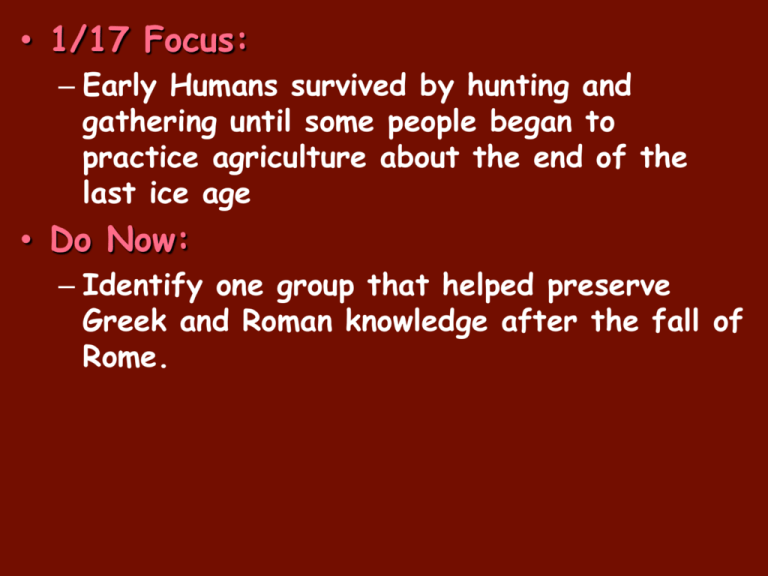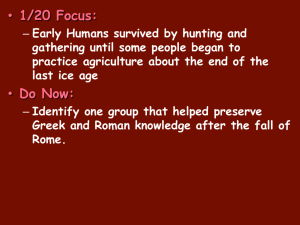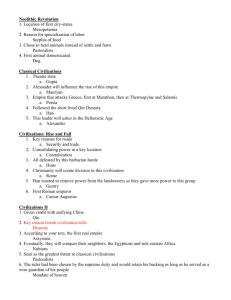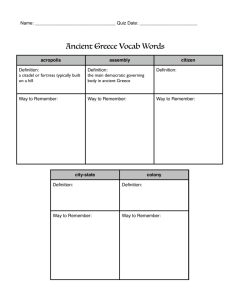Midterm Review
advertisement

• 1/17 Focus: – Early Humans survived by hunting and gathering until some people began to practice agriculture about the end of the last ice age • Do Now: – Identify one group that helped preserve Greek and Roman knowledge after the fall of Rome. Midterm Review Subsistence farming Primary Source Cultural Diffusion Secondary Source Natural Barriers Ethnocentrism Timeline Cultural Diffusion Natural Barriers Primary Source Secondary Source Subsistence farming • Timeline • Ethnocentrism • • • • • • The exchange of ideas, customs, goods, and technologies among cultures • Mountains, deserts, oceans are examples of factors that limit the movement of groups of people • A first hand source of information • Sources of information that usually occur after the event happened • Farming enough just to survive • a tool which shows the chronological order of events • Belief that one’s culture is superior to all others Sample Questions 1. The main purpose of a time line is to show the (1) causes and effects of wars (2) location of important places (3) benefits of modern civilizations (4) chronological relationship between events 2. Which source of information is considered a primary source? (1) travel diary of Ibn Battuta (2) modern novel about the Golden Age of Islam (3) textbook on the history of North Africa (4) dictionary of English words adapted from Arabic 3. Which document is an example of a primary source? (1) a novel on the Age of Discovery (2) a diary of a Holocaust survivor (3) a textbook on Latin American history (4) an encyclopedia article on Songhai culture 4. The term “subsistence farmers” refers to people who grow (1) enough food to feed an entire village (2) food to sell in village markets (3) just enough food to meet the needs of the immediate family (4) a single cash crop Primary Source Secondary Source Journal Entry Textbook Video showing President Wikipedia entry Kennedy being assassinated about ancient China Autobiography Newspaper article written during the Civil War Documentary on Ancient Egypt Biography Description • Study of ancient remains and artifacts of culture • Study of the exchange of goods and services; scarcity of resources • Study of the earth and its features, location; movement of people • Study of society • Study of historical events; uses primary sources • Study of the origin, physical development, and culture of humans Fields of Study • • • • • • Archeology Economics Geography Sociologist History Anthropology Sample Questions 1. Which social scientist primarily studies how people change resources into goods and services? (1) archaeologist (2) economist (3) sociologist (4) psychologist 2. Which social scientists are best known for studying the physical artifacts of a culture? (1) geographers (2) economists (3) archaeologists (4) sociologists 3. Which aspect of social science would a geographer be most likely study? (1) how beliefs influence a group (2) how economic events influence history (3) how location influences how we live (4) how people make decisions about government • The belief that human life began in the Great Rift Valley or East Africa is known as the__________________ theory. A leading archeologist who supports this theory is Mary _______________ Answers: Out of Africa Theory Leakey • Nomadic people • Basic stone age tools such as flint • Primarily hunter/gathers • Moved with their food sources • Start of Agriculture • Domestication of Animals • Farming communities developed • Allowed for the birth of cities and then civilizations • A major turning point in human history Sample Questions 1. The Neolithic Revolution is considered a turning point in history because it (1) influenced climatic changes (2) included the domestication of plants and animals (3) encouraged a nomadic lifestyle (4) caused a decline in population 2. The Neolithic Revolution was characterized by the (1) change from nomadic herding to settled farming (2) growth of iron tool-making technology (3) migration of early peoples to the Americas (4) decline of large empires 3. What was an important result of the Neolithic Revolution? (1) Food supplies became more reliable. (2) New sources of energy became available. (3) People became more nomadic. (4) Populations declined. Art/Architecture Organized Religion Cities Job Specialization Government Public Works System of Writing Social Classes • 1/15 Focus: – The world’s first civilizations developed in River Valleys. – The people of these civilizations not only formed empires but developed writing and religious traditions • Do Now: – Identify one early form of writing River Valley Civilizations • List three common characteristics found in each of these locations. • Identify the civilization that each geographic characteristic is most closely associated. Nile River Valley Himalayas (2) Khyber Pass Tigris & Euphrates Waterfalls and Sahara Desert Fertile Crescent Yellow River Indus River Monsoons Gobi Desert Hindu Kush Natural Barriers (3) Unpredictable River flooding (3) Predictable Flooding (1) Lack of Natural Barriers • Identify the civilization that each term is associated with: Ziggurats Mohenjo-Daro Pyramids Dynastic Cycle Harappa Mandate of Heaven Book of the Dead Aryans Hanging Gardens of Babylon Hieroglyphics Cuneiform Pharaohs Han Dynasty Caste System Maurya and Gupta Empires Gilgamesh Sample Questions These architectural achievements best indicate that (1) advanced technology existed in early civilizations (2) religion was of little importance (3) entertainment was important to these ancient societies (4) trade routes existed between China and the Americas One similarity between the ancient civilizations in Egypt and in China is that they developed (1) nomadic lifestyles (2) monotheistic belief systems (3) democratic governments (4) written forms of communication • 1/21 Focus: • Early empires had different ideas about government and the role of citizens. • Athens in Greece developed the form of government known as democracy and Rome developed the republic. • Do Now: – What is Dharma? • Early humans believed that everything living and nonliving in nature has a spirit this is known as Animism _____________ • Belief in many gods • Belief in one god • All religions have rules or codes of behavior – – – – 10 Commandments Five Pillars Eightfold Path Five Relationships • Polytheism • Monotheism • • • • Judaism and Christianity Islam Buddhism Confucianism • • • • • Reincarnation Dharma Karma Moksha Nirvana • The cycle of birth, death, and rebirth • The moral and religious duties expected of a person • What you do in this life effects your next life • Union with the Brahman (Atman) • enlightenment – Compare and contrast Hinduism and Buddhism Eightfold Path Karma Dharma Brahman Moksha Nirvana Four Noble Truths No founder Reincarnation Atman The Caste System Founded by Siddhartha Guatma • Philosophies (Confucianism, Legalism, Taoism) – Identify the philosophy associated with each term, name, or statement The Five Relationships Seek a balance with nature Lao Tzu “The Way” Harsh penalties for breaking laws Filial Piety Strict control of education and free thinking Placed high value on education rather than punishment Sample Questions 1. One way in which the Five Relationships, the Ten Commandments, and the Eightfold Path are similar is that they: (1)promote polytheism (2)provide codes of behavior (3)establish gender equality (4)describe secularism 2. Christianity, Islam, and Judaism are similar in that they all ask their followers to (1)believe in reincarnation (2)strive for nirvana (3) follow a code of behavior (4) practice polytheism Sample Questions 3. Which action is most closely associated with polytheism? (1)praying in a synagogue (2)worshipping many gods (3) accepting the Eightfold Path (4) reading the Koran 4. The five relationships taught by Confucius encouraged people to (1) improve their position in life (2) maintain social and political order (3) respect and worship nature (4) serve the needs of religious leaders Sample Questions 5. Which factor most influenced a person’s social position in early Indian societies? (1)education (2)geographic location (3) birth (4)individual achievement • Buddhism is introduced into Japan around A.D. 1200. • Islam extends from the Middle East into Spain by A.D. 732. • Catholic and Protestant missionaries bring Christianity to Africa in the 1800s. 6. Each of these statements reflects the concept of (1) cultural diffusion (2) civil disobedience (3) urbanization (4) isolationism • Earliest evidence of codified law; eye for an eye if citizens are of equal classes • Code of Law in Ancient Rome • Developed by the Emperor Justinian; preserved Roman Law • Developed during the Maurya Dynasty in India; displayed on Pillars throughout the empire • Code of Hammurabi • 12 Tables of Rome • Justinian’s Code • Pillars of Asoka Sample Questions 1. The Code of Hammurabi was a major contribution to the development of civilization because it (1)treated citizens and slaves equally (2)recorded existing laws for all to see (3) ended all physical punishment (4) rejected the principle of filial piety 2. The importance of the Code of Hammurabi, the Twelve Tables, and the Justinian Code is that they (1)established legal principles (2)provided religious freedom (3) instituted democratic governments (4) promoted equality for all classes • Geography – Mountainous terrain led to the formation of __________________ – Greece is a __________________ surrounded by the Aegean, Ionian, and Mediterranean Sea – Coastline of Greece is irregular which gives them natural _________________ • City States • Peninsula • Harbors Athens • Practiced direct democracy • Citizens played a direct role in government • Focused on education • Socrates, Plato, and Aristotle emphasized philosophy and reason Sparta • Focused on Military • Education was focused on military training • Established a large empire that spread from Greece to India and spread into the Middle East and Egypt • Created Hellenistic Culture which blended: – – – – __________________ _________________ __________________ ___________________ • This is an example of __________ • • • • • Indian Egyptian Persian Greek Cultural Diffusion • Low hills and few natural barriers allowed for the Italian peninsula to be easily _________ • Peninsula located in the ___________________Sea • allowed for ______ and _______________ United Mediterranean Trade Expansion • Government in Rome was a _____________ – Citizens elected their officials to make laws • Caesar became a _________________ and limited the power of the Senate • Augustus Caesar became the first _________________ marking the end of the Republic • Republic • Dictator • Emperor Sample Questions 1. What was one cause of the development of many small independent citystates in ancient Greece? (1) Greece and Rome were often at war. (2) The mountainous terrain of Greece resulted in widely scattered settlements. (3) Military leaders found small Greek settlements easy to control. (4) The Greek people had many different languages and religions. 2. One contribution of ancient Roman culture was the development of (1) the concept of zero (2) a republican form of government (3) the process of making silk (4) the printing press Classical Chinese Dynasty Specific Characteristics Zhou Dynasty Qin Dynasty Han Dynasty - - used mandate of heaven to claim authority worked to centralize the government expanded territory to the south (Yangtze River Valley rulers (emperors) referred to themselves as Sons of Heaven standardized spoken language expanded territory to the south (northern Vietnam) construction of the Great Wall standardized: weights, measures, money, written language construction of new roads expanded territory south and west (central Asia, Korea, Indochina) civil service exams based on Confucian values trade increased (Silk Roads) relative time of peace technology: iron production, canals, irrigation systems, oxdrawn plows, collar for beasts of burden, paper manufacture, water-power mills social structure: elites, peasants, artisans, unskilled laborers Classical India Maurya Empire Specific characteristics - Gupta Empire - Chandragupta founds Mauryan dynasty large army, united almost all of Indian subcontinent large bureaucracy established Ashoka (grandson of Chandragupta) known for ruthless conquering of India, later converted to Buddhism and helped spread Buddhism along the roads of India construction of roads that connected to China’s Silk Roads After Ashoka’s death, kingdom divided again and invaders from the North ruled India until the Gupta’s rose to power Hindu rulers, reinforcement of Hindu values, but Buddhism was tolerated local rulers retained control over local territories, provided they complied with Gupta law Religion: solidification of Hindu values and traditions, construction of Hindu temples; Buddhism spread through urban monasteries Patriarchy: women gradually lost status and privileges, married at younger age, sati (widow suicide by burning) Sanskrit becomes language of educated Technology/discoveries: zero as placeholder, Arabic numerals, decimal system, knowledge of astronomy, knowledge of surgical procedures and the prevention of illnesses Trade: increase in volume of trade, especially with the East Sample Questions 3. In a comparison of the ancient cities of Athens and Sparta, Sparta placed more emphasis on (1)education (2)family order (3) military service (4)human rights 4. Which society practiced direct democracy? (1)ancient Athens (2)Gupta Empire (3)dynastic China (4)early Egypt Sample Questions 5. In Western Europe, the Middle Ages began after the collapse of which empire? (1)Mughal (2)Ottoman (3)Roman (4)Byzantine 6. What was one effect of Alexander the Great’s conquests? (1)expansion of Hellenistic culture (2)decreased importance of the Silk Roads (3)formation of the Christian church (4)increased support of the Mayan leaders Feudalism • Political and social system based on the granting of land in exchange for loyalty, military assistance, and other services • Land for protection Manorial System • An economic system in the Middle Ages that was built around farming on large estates called manors • Manors were selfsufficient – Produced everything they need on the manor







